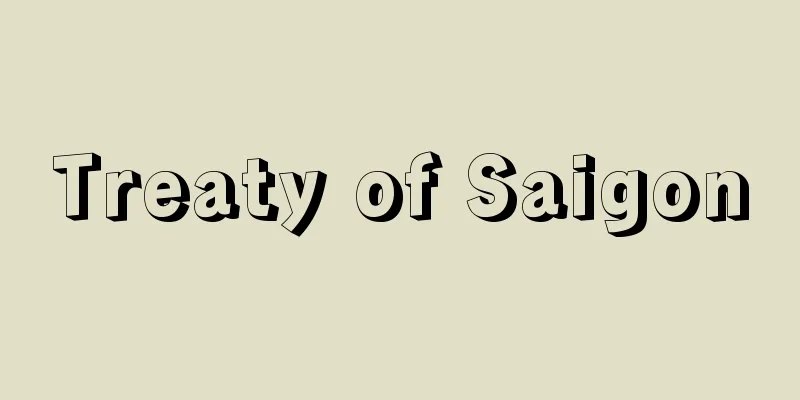Treaty of Saigon

|
A treaty concluded between France and Vietnam (the Nguyen Dynasty). There was the first treaty in 1862 and the second treaty in 1874. In 1858, France attacked Tourane (Da Nang) on the grounds of persecution of missionaries, and the following year occupied Saigon (now Ho Chi Minh City), further expanding its influence to Bien Hoa, Vinh Long and other areas. At the time, the Nguyen Dynasty in Hue (Hue) was suffering from rebellions in the north, and in order to avoid this crisis of internal and external threats, they sent Phan Ching-jian (Phan Thanh Giang) and others to Saigon, and concluded the First Treaty of Saigon on June 5, 1862. As a result, France forced Vietnam to accept the cession of the three eastern provinces of Cochinchina (southern), the freedom to spread Christianity throughout the country, and the opening of ports such as Tourane. After that, the Hue Imperial Court demanded the withdrawal of the territorial cession, and France initially agreed, resulting in the conclusion of a treaty of return in 1864, but France did not ratify it due to domestic opposition. Meanwhile, the French Navy, which had established a base in Saigon, invaded the three western provinces of Cochinchina in 1867, practically annexing them, and then turned its attention to the invasion of Tonkin in the north. In 1873, they conspired with a French merchant to cause the Tonkin Incident, but the French government dispatched Philistre to settle the matter, and concluded the Second Treaty of Saigon (Philastre Treaty) with the Hue Imperial Court on March 15, 1874. As a result, France was officially recognized as having ceded the three western provinces of Cochinchina, and also acquired trade rights on the Red River (Son Khoi River), the right to open consulates in Hanoi and other places, and the right to station a commissioner in Hue. The events that followed show that France's conquest of Vietnam was carried out through a trinity of efforts: the navy (against Britain), missionaries (proselytizing), and merchants (trade). [Masaya Shiraishi] "Modern History of Southeast Asia III" by Yukio Sakurai and Yoshiaki Ishizawa (1977, Yamakawa Publishing) Source: Shogakukan Encyclopedia Nipponica About Encyclopedia Nipponica Information | Legend |
|
フランスとベトナム(阮(げん)朝)の間に結ばれた条約。1862年の第一次条約と74年の第二次条約とがある。フランスは1858年、宣教師迫害を理由としてトゥーラン(ダナン)を攻撃し、翌年サイゴンSaigon(現ホー・チ・ミン市)を占領、さらにビエンホア、ビンロンなどに勢力を広げた。当時北部での反乱に悩んでいたフエ(ユエ)の阮朝廷は、この内憂外患の危機を回避するために潘清簡(ファン・タインザン)らをサイゴンに派遣、62年6月5日第一次サイゴン条約を結んだ。これによってフランスは、コーチシナ(南部)東三省の割譲と、全土におけるキリスト教布教の自由、トゥーランなどの開港をベトナムに認めさせた。 その後フエの朝廷は領土割譲の撤回を求め、フランスもいったんはこれに同意し、64年に返還条約が結ばれたが、フランスは結局国内の反対にあってこれを批准しなかった。他方サイゴンに拠点を築いたフランス海軍は67年にはコーチシナの西三省に進駐し、これを事実上併合し、さらにその関心を北部のトンキン攻略に向けた。彼らはフランス人一商人と結託して73年にトンキン事件を引き起こしたが、フランス政府は事件の収拾のためにフィラストルを派遣し、フエの朝廷との間に74年3月15日第二次サイゴン条約(フィラストル条約)を結んだ。これによってフランスはコーチシナ西三省の割譲を正式に認めさせるとともに、紅河(ソン・コイ川)の通商権、ハノイなどでの領事館開設、フエの理事官駐在の権利などを獲得した。フランスのベトナム攻略が海軍(イギリスへの対抗)、宣教師(布教)、商人(通商)の三位(さんみ)一体でなされたことを、この間の経緯がよく物語っているといえよう。 [白石昌也] 『桜井由躬雄・石澤良昭著『東南アジア現代史Ⅲ』(1977・山川出版社)』 出典 小学館 日本大百科全書(ニッポニカ)日本大百科全書(ニッポニカ)について 情報 | 凡例 |
Recommend
The shady money scandal
An uprising that broke out in Shinano, Echigo, Kai...
ankle joint
...the patella reduces the friction that occurs b...
Flower moon scroll - Kagetsumaki
〘 noun 〙 (named after the proprietress of the rest...
Dental alloys
Alloys used to repair teeth. Metal materials are u...
Snefru
...For this reason, the Old Kingdom is also calle...
Imperial Guard
〘 noun 〙 In China, the military guards of the empe...
Passive object love - ukemikitaishoai
...In other words, it is the desire to feel close...
Crocodile - Kurokodairu (English spelling) crocodile
A general term for crocodiles belonging to the or...
Sulfuric acid - Ryusan (English spelling)
Chemical formula: H2SO4 , formula weight : 98.1. ...
Kamihayashi [village] - Kamihayashi
A village in Iwafune County in northern Niigata Pr...
Meridiem
…In British and American English, am and pm are o...
Royal Horse
〘Noun〙 ("O" is a prefix) The name of a t...
Multiculturalism
…It is a translation of the word multiculturalism...
Audiencia Presidential - Audiencia Presidential
…It was the longest-lasting and most stable of th...
Etiol - Etiol
…Reindeer bones are by far the most common, but b...









